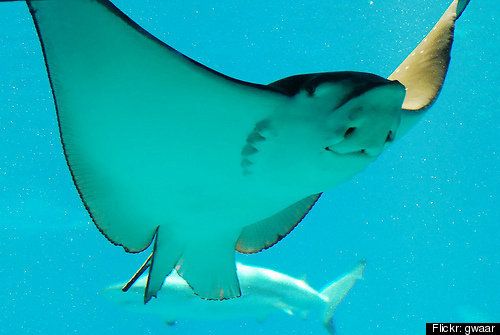
Ever since man ventured out to sea, stories about bizarre marine life have filled our folklore and literature. From tales of ancient sea monsters to Melville's Moby-Dick, from purported sightings of the Loch Ness Monster to films such as 2007's The Water Horse: Legend of the Deep and 2009's Mega Shark Versus Giant Octopus, the depths of the ocean are nothing compared to the depths of our fear. Why bother with the attempts at authenticity in a movie like 1975's Jaws when you can watch truly entertaining trash like Shark Attack III: Megalodon?
From ancient tales of the lost city of Atlantis to Jules Verne's 1870 classic, 20,000 Leagues Under The Sea, life under the sea has been a never-ending source of fear and fantasy. Recently, plans were announced heralding the construction of the new Water Discus Underwater Hotels in Dubai.

Photo courtesy of Deep Ocean Technology
If we examine how images of marine life are sprinkled throughout our culture, the results are often surprising:
- Detectives have been known to claim that "something smells fishy about this."
- When leadership comes under criticism, someone is bound to point out that "the fish stinks from the head."
- In Mafia parlance, stating that someone is "swimming with the fishes," is a sure indicator that he's dead.
- Fisherman often boast about the size of the fish that got away.
- Mystery readers are often led astray by a red herring.
- Roman Catholics used to be called mackerel snappers (to this day, a popular expression is "Holy mackerel!").
- Weak swimmers are often referred to as shark bait.
- Many a piece of fiction has been described as "a whale of a tale."
- A popular warning about overstaying one's welcome is to remind someone that "After a few days guests, like fish, start to stink."
- In 1994, Kevin Spacey and Frank Whaley starred in Swimming With Sharks.
- A leather friend of mine liked to brag about the sexual connotation of his screen name (a stingray is a bottom feeder).
And what about 2012's fishy comedy gorefest, Piranha 3D.?
Professional animators (like those associated with Pixar and the Walt Disney Animation Studios) usually take a more benign approach to depicting life under the sea. Full-length features like 1940's Pinocchio, 1989's The Little Mermaid, and 2003's Finding Nemo hit pay dirt when they turned their attention toward depicting marine life.
* * * * * * * * * *
This year's San Francisco International Film Festival included two shorts with strong images of fish, whales, and other seagoing creatures.
I especially liked the imagination on display in Julia Pott's 8-minute short entitled Belly.
* * * * * * * * * *
Not all creatures that swim are as terrifying as great white sharks, giant squid, and plesiosaurs. Freshwater fish are decidedly less fearsome and may nibble at bait and lures instead of taking giant, lunging bites.
Often found in mountain lakes and streams, trout have intrigued and fed people for hundreds of years. Until recently, few would associate fresh trout with life in World War II's Japanese-American internment camps. But, as The Manzanar Fishing Club makes clear, trout fishing helped give many of the Japanese interned at California's infamous Manzanar camp a sense of purpose and pride.
It took many years before those who were rounded up and sent to America's Japanese internment camps were willing to speak about the experience. Starting in the 1970s, however, a series of documentary films about Manzanar began to emerge. They include:
- 1972's Manzanar.
- 1976's Farewell To Manzanar.
- 2010's Moonrise Over Manzanar.
- 2010's A Crossroad Called Manzanar.
In 2009, documentarian Ken Burns filmed a PBS miniseries about America's National Parks. The following section was devoted to Manzanar:
Written by Richard Imamura and directed by Cory Shiozaki (who, for many years was a licensed and bonded trout fishing guide for the Eastern Sierra range), The Manzanar Fishing Club is filled with archival footage, family photographs, and stories about life in California's internment camp. Few people would have imagined that internees were able to use the Sears Roebuck and Montgomery Ward catalogs to order fishing gear by mail. Nor is it easy to imagine the emotions of the Japanese-American internees who could smell fresh trout cooking on kerosene stoves.
While The Manzanar Fishing Club tries to explain how various types of trout (golden trout, rainbow trout, etc.) initially found their way to the lakes high in the Eastern Sierra, the film's strength lies in the testimony of Japanese Americans who snuck out of camp (even if it meant hiding in garbage cans) to go fishing. This poignant documentary produced by film industry veterans (whose parents were internees) will have special meaning for anyone who likes to fish. Here's the trailer:
To read more of George Heymont go to My Cultural Landscape
